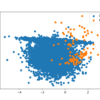Deep learning neural networks are a flexible class of machine learning algorithms that perform well on a wide range of problems. Neural networks are trained using the backpropagation of error algorithm that involves calculating errors made by the model on the training dataset and updating the model weights in proportion to those errors. The limitation […]










